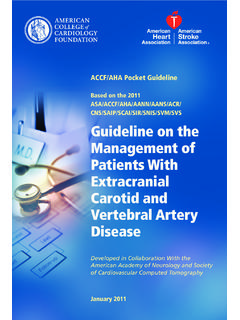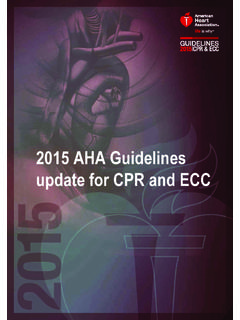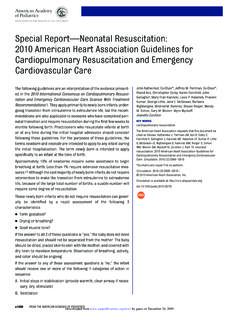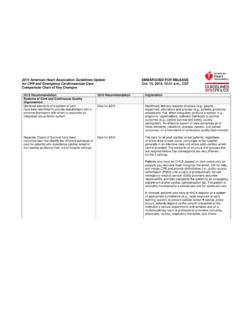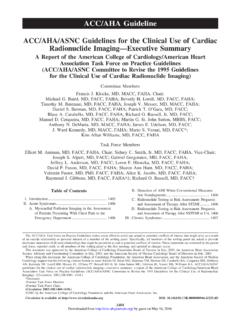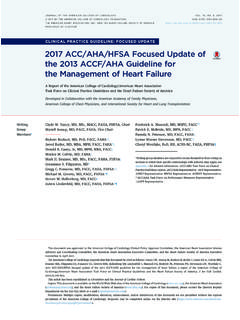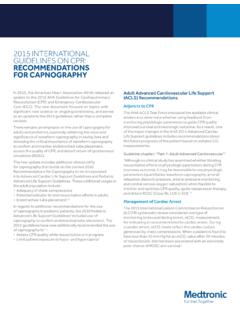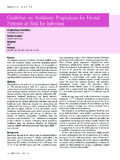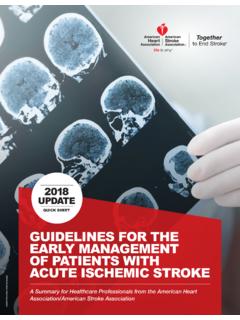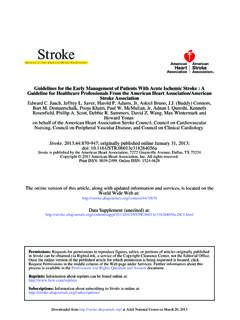Transcription of March 2010 - American Heart Association
1 Learn and LiveSMACC/AHA Pocket Guideline Based on the 2010 ACCF/AHA/AATS/ACR/ASA/SCA/SCAI/SIR/STS/S VM guidelines for the Diagnosis and Management of Patients With Thoracic Aortic DiseaseMarch 2010iGuidelines for the Diagnosis and Management of Patients With Thoracic Aortic DiseaseMarch 2010 Writing CommitteeLoren F. Hiratzka, MD, ChairGeorge L. Bakris, MDJoshua A. Beckman, MD, MSRobert M. Bersin, MPH, MDVincent F. Carr, DODonald E. Casey, Jr, MD, MPH, MBAKim A. Eagle, MDLuke K. Hermann, MDEric M. Isselbacher, MDElla A. Kazerooni, MD, MSNicholas T.
2 Kouchoukos, MDBruce W. Lytle, MDDianna M. Milewicz, MD, PhDDavid L. Reich, MDSouvik Sen, MD, MSJulie A. Shinn, RN, MA, CCRNLars G. Svensson, MD, PhDDavid M. Williams, MD 2010 American College of Cardiology Foundation and American Heart Association , following material was adapted from the 2010 ACCF/AHA/AATS/ACR/ASA/SCA/SCAI/SIR/STS/S VM guidelines for the Diagnosis and Management of Patients With Thoracic Aortic Disease: Executive Summary (Circulation 2010 ;121:1544 79). This pocket guideline is available on the World Wide Web sites of the American College of Cardiology ( ) and the American Heart Association ( ).
3 For copies of this document, please contact Wolters Kluwer Health Medical Research, Lippincott Williams & Wilkins, email: Tel: ; Fax: : Multiple copies, modification, alteration, enhancement, and/or distribution of this document are not permitted without the express permission of the American Heart Association . Instructions for obtaining permission are located at A link to the Permission Request Form appears on the right side of the page. Contents1. Introduction ..62. Critical Issues ..103. Recommendations for Aortic Imaging Techniques to Determine the Presence and Progression of Thoracic Aortic Disease.
4 144. Recommendations for Genetic Syndromes ..185. Recommendations for Familial Thoracic Aortic Aneurysms and Dissections ..246. Recommendations for Bicuspid Aortic Valve and Associated Congenital Variants in Adults ..267. Recommendations for Estimation of Pretest Risk of Thoracic Aortic Dissection ..278. Initial Evaluation and Management of Acute Thoracic Aortic Recommendations for Screening Tests ..34 Recommendations for Diagnostic Imaging Studies ..35 Recommendations for Initial Management ..36 Recommendations for Definitive Management.
5 379. Recommendation for Surgical Intervention for Acute Thoracic Aortic Dissection ..412310. Recommendation for Intramural Hematoma Without Intimal Recommendation for History and Physical Examination for Thoracic Aortic Disease ..4312. Recommendation for Medical Treatment of Patients With Thoracic Aortic Diseases ..44 Recommendations for Blood Pressure Control ..4413. Recommendations for Asymptomatic Patients With Ascending Aortic Aneurysm ..4614. Recommendation for Symptomatic Patients With Thoracic Aortic Aneurysm ..5015.
6 Recommendations for Open Surgery for Ascending Aortic Aneurysm ..5116. Recommendations for Aortic Arch Aneurysms ..5217. Recommendations for Descending Thoracic Aorta and Thoracoabdominal Aortic Aneurysms ..5418. Recommendations for Counseling and Management of Chronic Aortic Diseases in Pregnancy ..5619. Recommendations for Aortic Arch and Thoracic Aortic Atheroma and Atheroembolic Disease ..584520. Periprocedural and Perioperative Management ..59 Recommendations for Brain Protection During Ascending Aortic and Transverse Aortic Arch Surgery.
7 59 Recommendations for Spinal Cord Protection During Descending Aortic Open Surgical and Endovascular Repairs ..6021. Recommendations for Surveillance of Thoracic Aortic Disease or Previously Repaired Patients ..6222. Recommendation for Employment and Lifestyle in Patients With Thoracic Aortic Disease ..6461. IntroductionThe term thoracic aortic disease encompasses a broad range of degenerative, structural, acquired, genetic-based, and traumatic disease states and pre-sentations. According to the Centers for Disease Control and Prevention death certificate data, dis-eases of the aorta and its branches account for 43 000 to 47 000 deaths annually in the United States.
8 The precise number of deaths attributable to thorac-ic aortic diseases is unclear. However, autopsy stud-ies suggest that the presentation of thoracic aortic disease is often death due to aortic dissection (AoD) and rupture, and these deaths account for twice as 7many deaths as attributed to ruptured abdominal aortic aneurysms (AAAs). This guideline includes diseases involving any or all parts of the thoracic aorta with the exception of aortic valve diseases and includes the abdominal aorta when contiguous tho-racic aortic diseases are 1.
9 Applying Classification of Recommendations and Level of Evidence LeveL AMultiple populations evaluated*Data derived from multi-ple randomized clinical trials or meta-analysesLeveL BLimited populations evaluated*Data derived from a single randomized trial or nonrandomized studiesLeveL CVery limited populations evaluated*Only consensus opinion of experts, case studies, or standard of careCLASS IBenefit >>> RiskProcedure/Treatment shOuLD be performed/ administeredn Recommendation that procedure or treatment is useful/effectiven sufficient evidence from multiple randomized trials or meta-analysesn Recommendation that procedure or treatment is useful/effectiven Limited evidence from single randomized trial or nonrandomized studiesn Recommendation that procedure or treatment is useful/effectiven Only expert opinion, case studies.
10 Or standard of careCLASS IIAB enefit >> RiskAdditional studies with focused objectives neededIT Is ReasOnabLe to per-form procedure/administer treatmentn Recommendation in favor of treatment or procedure being useful/effectiven some conflicting evidence from multiple randomized trials or meta-analysesn Recommendation in favor of treatment or procedure being useful/effectiven some conflicting evidence from single randomized trial or nonrandomized studiesn Recommendation in favor of treatment or procedure being useful/effectiven Only diverging expert opinion, case studies, or standard of careshouldis recommendedis indicatedis useful/effective/beneficialsuggested phrases for writing recommendations is reasonablecan be useful/effective/beneficialis probably recommended or indicatedSIzE OF TREATMEnT EFFECTESTIMATE oF CERTAInTy (PRECISIon) oF TREATMEnT EFFECT9 Class IIbBenefit RiskAdditional studies with broad objectives needed.
